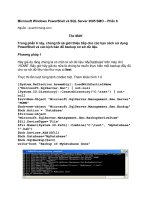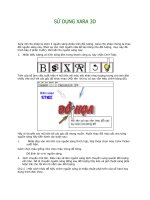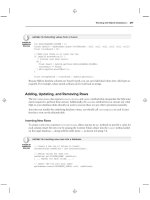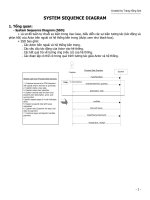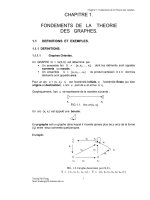Oracle Reports tutorial phần 6 ppt
Bạn đang xem bản rút gọn của tài liệu. Xem và tải ngay bản đầy đủ của tài liệu tại đây (73.1 KB, 8 trang )
Glossary-5
substantial savings through reduced complexity, better manageability, and simplified
development and deployment. OracleAS provides the only business-critical platform
that offers easy database Web publishing and complete legacy integration while
transitioning from traditional client/server to network application architectures.
Oracle Developer Suite
Combines leading Oracle application development and business intelligence tools into
a single, integrated product. Built on Internet standards such as Java and XML, the
suite provides a complete and highly productive development environment for
building applications for Oracle Application Server and the Oracle database.
ORACLE_HOME
An alternate name for the top directory in the Oracle directory hierarchy on some
directory-based operating systems. An environment variable that indicates the root
directory of Oracle products.
You can refer to the directory specified by ORACLE_HOME in syntax:
On UNIX: $ORACLE_HOME
On Windows: %ORACLE_HOME%
OracleAS Portal
A browser-based development tool for building scalable, secure, extensible HTML
applications and Web sites. OracleAS Reports Services uses OracleAS Portal to control
end user access to reports published on the Web by storing information about report
requests, the secured server, and any OracleAS Reports Services printer used to print
report output.
OracleAS Reports Services
See Reports Services.
Paper Design view
One of the views of the Report Editor that displays output for paper reports and
enables you to make many commonly required, simple modifications to the layout,
such as spacing, formatting fields, color, and editing text, without having to open the
Paper Layout view.
Paper Layout view
One of the views of the Report Editor that displays the layout objects in a paper report
and enables you to make many modifications to any layout object. All layout objects
have properties that you can modify using the Property Inspector. The hierarchy of the
layout objects is determined by the Data Model.
Paper Parameter Form view
Displays the layout of the Parameter Form that, at runtime, allows user input of
parameter values in the Runtime Parameter Form.
Acronym for Portable Document Format. A file format (native for Adobe Acrobat) for
representing documents in a manner that is independent of the original application
software, hardware, and operating system used to create the documents. A PDF file
can describe documents containing any combination of text, graphics, and images in a
device-independent and resolution independent format.
Glossary-6
PL/SQL
Oracle's proprietary extension to the SQL language. Adds procedural and other
constructs to SQL that make it suitable for writing applications.
PPD
Acronymn for PostScript Printer Definition. PPD and AFM files are supplied by
Adobe and by printer vendors. These files contain information about the printer.
Along with other parameters, these files are read for the information about the
available fonts for the printer, which Oracle Reports will use. For all the fonts listed in
the PPD file, Oracle Reports searches for the corresponding AFM file according to the
font name and loads all of the fonts for which there is an available AFM.
Property Inspector
A window that enables you to view, locate, and set the properties of the currently
selected object(s) in the Object Navigator, Report Editor, and Template Editor. Every
Reports Builder object (query, group, frame, parameter, and so on) has associated
properties that can be viewed using the Property Inspector. The Property Inspector
features:
■ expandable and collapsible nodes
■ in-place property editing
■ search features
■ multiselection
■ complex property dialogs
■ the ability to invoke multiple instances of the Property Inspector
To get help on any property, click the property in the Property Inspector and press F1.
query
A SQL SELECT statement that specifies the data you wish to retrieve from one or more
tables or views of a database.
RDF file
A file that contains a single report definition in binary format. .RDF files are used to
both run and edit reports.
record
One row fetched by a SQL SELECT statement.
REP file
A file that contains a single report definition in binary format. .REP files are used
solely to run reports; you cannot edit a .REP file.
repeating frame
A layout object used to display rows of data that are fetched for a group.
Reports Cache
A component of OracleAS Reports Services that stores completed jobs output.
Glossary-7
Reports CGI (rwcgi)
An Oracle Reports executable, also known as the Common Gateway Interface (CGI) or
Reports Web Cartridge, that translates and delivers information between either a Web
Server or a J2EE Container (for example, OC4J) and the Reports Server, to run a report
dynamically from your Web browser.
Reports Client (rwclient)
An Oracle Reports executable that provides a command-line interface to send a report
to a remote Reports Server (rwserver).
Report Editor
The Reports Builder window that provides different views to help you handle the data
objects and layout objects for Web and paper reports. The views are:
■ Data Model view
■ Paper Layout view
■ Paper Design view
■ Paper Parameter Form view
■ Web Source view
Reports Engine
A component of OracleAS Reports Services that fetches data from the data source,
formats the report, send output to cache, and notifies the Reports Server that the job is
ready.
Reports Builder (rwbuilder)
An Oracle Reports executable that provides a design-time user interface to enable
report developers to create and maintain report definitions.
Reports Queue Manager (rwrqm)
(Windows only) Maintains timestamp and status information about reports jobs
managed by the Reports Server (rwserver).
Reports Runtime (rwrun)
An Oracle Reports executable that runs a report using the OracleAS Reports Services
in-process Reports Server.
Reports Server (rwserver)
An Oracle Reports executable that provides reporting services to execute, distribute,
and publish your reports for enterprise-wide reporting. A component of OracleAS
Reports Services that processes client requests, including user authentication,
scheduling, caching, and report distribution. Use Oracle Reports clients such as
rwservlet, Reports JSP, CGI, and rwclient send a report to Reports Server.
Note: With Oracle Reports 10g, Reports CGI (rwcgi) is
deprecated (maintained only for backward compatibility); instead,
use Reports JSPs, rwservlet (Reports Servlet), or Reports Web
Services.
Glossary-8
Reports Services
The runtime environment for Reports Developer applications. OracleAS Reports
Services executes, distributes, and publishes your reports for enterprise wide
reporting. Using OracleAS Reports Services to deploy your reports results in gains of
flexibility, time savings, and processing capacity.
Reports Servlet (rwservlet)
A component of OracleAS Reports Services that translates and delivers information
between either a Web Server or a J2EE Container (for example, OC4J) and the Reports
Server, enabling you to run a report dynamically from your Web browser.
row
One set of field values in a table; for example, the fields representing one employee in
the example table EMP.
Runtime Parameter Form
A screen or window appearing optionally at runtime in which a user can modify print
options and parameters prior to report execution.
schema
A collection of related database objects, usually grouped by database user ID. Schema
objects include tables, views, sequences, stored program units, synonyms, indexes,
clusters, and database links.
SELECT statement
A SQL statement that specifies which rows and columns to fetch from one or more
tables or views.
servlet
A Java application that runs in a Web server or application server and provides
server-side processing, typically to access a database or perform e-commerce
processing. Because they are written in Java, servlets are portable between servers and
operating systems.
The Reports Servlet (rwservlet) and JSP are components of OracleAS Reports
Services that process custom (JSP) report tags and deliver information between the
Oracle HTTP Server and the Reports Server.
SQL
A standard interface for storing and retrieving information in a relational database.
SQL is an acronym for Structured Query Language.
SQL file
A file that contains a query stored in text (for example, ASCII or EBCDIC) format.
SQL script
A file containing SQL statements that you can run to perform database administration
quickly and easily. Several SQL scripts are shipped with Oracle products.
SQL statement
A SQL instruction to Oracle. A SELECT statement is one type of SQL statement.
Glossary-9
style sheet
HTML extensions that provide powerful formatting flexibility in HTML documents.
To view an HTML document that takes advantage of style sheets, display it in a
browser that supports style sheets.
table
A named collection of related information, stored in a relational database or server, in
a two-dimensional grid that is made up of rows and columns.
tabular
A default layout displaying labels at the top of the page and rows of data underneath
the labels.
template
A skeleton definition containing common style and standards, and may include
graphics. A template provides a standard format to enable quick and easy
development of professional standard look-and-feel reports.
Template Editor
A work area in which you can define objects and formatting properties for your
templates. It is similar to the Paper Layout view of the Report Editor. You can create,
delete, and modify objects (for example, page numbers, text, and graphics) in the
margin area. You cannot create and delete objects in the body area, but you can
modify the properties of body objects in the Property Inspector.
tool
An iconic button used to create and manipulate objects in an application.
tool palette
A collection of tools represented by iconic buttons in the user interface that allow a
report developer to perform tasks, such as drawing a rectangle in the Paper Layout
view or creating a query in the Data Model view.
toolbar
A collection of iconic buttons that perform product commands. Usually aligned
horizontally along the top, or vertically down the side of a window.
URL
Acronym for Uniform Resource Locator. A compact string representation of the
location for a resource that is available through the Internet. It is also the text string
format clients use to encode requests to OracleAS.
view
1. In Reports Builder, a work area in which you perform a specific set of tasks, such
as defining a report data model, layout, or Parameter Form.
2. A virtual table whose rows do not actually exist in the database, but which is
based on a table that is physically stored in the database.
Web browser
A program that end users utilize to read HTML documents and programs stored on a
computer (serviced by a Web server).
Glossary-10
Web server
A server process (HTTP daemon) running at a Web site which sends out Web pages in
response to HTTP requests from remote Web browsers.
Web Source view
One of the views of the Report Editor that displays the HTML or JSP source for a
report. You can use this view to add dynamic content to a Web page using the Report
Block Wizard and the Graph Wizard. Experienced Java developers can edit the Web
source directly in this view.
wizard
A step-by-step interface for commonly performed tasks. The wizards in Reports
Builder are:
■ Report Wizard: guides you through the steps to create a basic paper or Web
report. Each page of the wizard asks you for information to help you create your
initial report.
■ Data Wizard: helps you helps you quickly define or modify a query for a
multiquery data models.
■ Graph Wizard: Adds variety of charts and graphs, including true 3-dimensional
graphs. Implemented in Reports Builder with the Oracle BI graph bean.
■ Report Block Wizard: enables you to add data to a static HTML page.
XML
Acronym for Extensible Markup Language. A metalanguage using SGML to define
and structure data. Reports Builder supports XML output to enable Web publishing as
well as electronic data exchange with third-party applications. You can also use XML
to build report definitions that can be merged with other report definitions at runtime
or run separately.
Index-1
Index
D
data
adding to a report, 2-1
adding to a Web report, 2-2
data model
creating, 2-1, 2-2
using for Web and paper report, 8-1
Data Wizard
glossary, Glossary-10
using, 2-2
G
graph
adding to a JSP, 6-1
reviewing the Web source, 7-1
Graph Wizard
glossary, Glossary-10
using, 6-2
H
header tag
reviewing, 5-1
HTML
opening a Web page in Reports Builder, 2-1
J
JavaServer Page, 6-4
saving, 2-5
JSP
adding a graph, 6-1
saving, 6-4
saving a JSP report, 2-5
O
overview, 1-1
P
paper report
creating, 8-1
R
report
creating a paper report, 8-1
saving as a JSP, 2-5
report block
adding, 4-1
reviewing the Web source, 5-1
Report Block Wizard
glossary, Glossary-10
Report Wizard
adding a report block, 4-1
glossary, Glossary-10
using, 8-1
Reports JSP tags
header tag, 5-1
rw
foreach tag, 5-1
graph tag, 7-1
seriesitem, 7-1
rw
foreach tag
reviewing, 5-1
graph tag
reviewing, 7-1
S
saving, 6-4
JSP-based Web report
saving, 6-4
scenario, 1-1
seriesitem tag
reviewing, 7-1
T
table designs
FormalKey, A-1, A-2
W
Web page
opening in Reports Builder, 2-1
Web source
reviewing a graph, 7-1
reviewing a report block, 5-1
Index-2
wizard
glossary, Glossary-10
